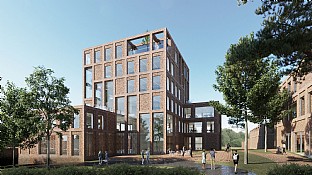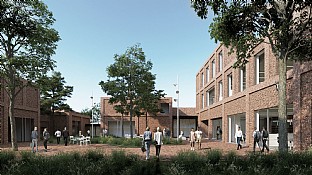The DTI's new campus area, which houses the most high-tech laboratories in the Nordic region, has an area of 50,000 m2 for research, development, and testing of digital and sustainable solutions. Designed to be sustainable over the long term, it has sections that can shrink and grow as new technological opportunities and developments emerge.
The campus area is designed as four clusters of 12 separate buildings occupying 8,000 m2 and will create a lively outline with varying dimensions and up to three levels. The buildings are arranged parallel to each other or at right angles, grouped around a courtyard where the main building acts as a hinge connecting the clusters.
The main building consists of three rectangular building masses with different dimensions and heights, and its six floors make it stand out as the anchor point for the DTI's campus area. The ground floor has large glass panels that provide an open, welcoming façade for the building, as a meeting point, with canteen, office space, and conference rooms.
Buildings at one with the landscape
A sense of variety is created in the façades by alternating between red and brown shades in the bricks and mortar, combined with glass panels. And a grid pattern in the brick façades creates rhythm and coherence between the clusters. At the same time, the architecture and the subdued tones ensure that the buildings form a natural part of the hilly landscape. This means that some buildings are planned to have a basement level below ground level at one end of the building, turning into a full ground floor at the other end of the building.
The windows in the experimental halls are arranged to make the most of natural daylight, taking in the natural surroundings and the activities in the courtyard area, as well as an outdoor feature called the Expo landscape, which is laid out as a green belt through the buildings. The Expo landscape is used for plant growth experiments and as a showcase area in both professional and recreational contexts for employees and other interested parties.
The overall architectural impression presents the buildings as a coherent whole, giving equal value to all functions of the buildings.






